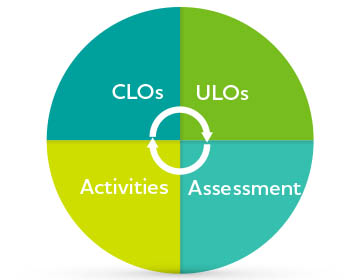Unit Learning Outcomes
A learning outcome is a statement of what a learner is expected to know, understand and be able to do at the end of a period of learning, and how a student is expected to demonstrate their achievement of the learning (Moon, 2002).
Constructive alignment
Learning outcomes must align with the overall course objectives and professional competencies, leading students toward a measurable level of skills, knowledge and performance.
There should be clear alignment between the unit content, learning activities and assessments, with the learning process guiding students towards achievement of the stated learning outcomes in a clearly scaffolded way. This process is known as constructive alignment (Biggs, 2014):
“In constructive alignment, start with the outcomes you intend students to learn and align teaching and assessment to those outcomes.”
In higher education, “traditional assessment tends to focus on remembering and repeating conceptual knowledge and understanding, whereas employability is more likely to be predicated on students’ ability to apply that knowledge in different contexts” (HEA, 2012, p. 12).
To achieve alignment, the following elements must all work together. See detailed Constructive alignment graphic.
Defining the outcomes
Learning outcomes should be written from the perspective of the student and should define the required level of knowledge, skills and understanding that students need to achieve by the end of the unit.
Learning outcomes should:
- Start with an action verb, recognising an appropriate level of achievement;
- Clarify the content and educational objectives;
- Communicate the learning purpose to students;
- Be observable and/or measurable;
- Indicate how the learning will be demonstrated, linking to assessment.
Start by considering these questions:
- What exactly do students need to learn?
- What is the required level of achievement?
- How will students demonstrate this achievement?
Once you have identified what students should know, be able to demonstrate and the level of achievement, it’s time to consolidate these elements into 2 or 3 main competences. Think about this: What transferrable capabilities will students have upon completion of the unit?
These capabilities will form the basis for the Unit Learning Outcomes and should extend beyond the content you intend to teach, the learning process that will be followed and the activities that will be completed.
Structure of a learning outcome
Learning outcomes should provide answers to the following statement: Upon completion of this unit, students will be able to …
There are three main sections in effectively written learning outcomes:
The verb at the start of the outcome is used to depict the action and level of complexity of the statement.
Bloom’s taxonomy verbs and the Revised Bloom’s taxonomy verbs are widely used to classify learning according to lower and higher levels of complexity. See the list below for some commonly used verbs.
The content description should explain the knowledge and skills that a student will perform, with some indication of the complexity or some observable measure of achievement. You may also wish to refer to the Australian Quality Framework (AQF) course level descriptors to help with determining complexity and achievement requirements for your unit
Context helps to define the purpose for the learning or any relevant circumstances under which the skills will be evidenced. Context is the element that supports development of authentic assessment activities. When adding context, identify the professional conditions or situations where the knowledge and skills will be applicable and identify the types of assessment activities that will allow students to show their capabilities.
Resources
ECU resources
- Writing Learning Outcomes Checklist - PDF File, 124.6 KB
- Writing Learning Outcomes Exemplars - PDF File, 151.8 KB
- Writing Learning Outcomes - PDF File, 255.8 KB
